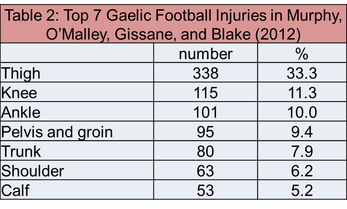
It is important to note that the information in Table 1 is based on the GAA injury scheme. Claims on the scheme for 2013 amounted to over €8m. One might argue that these are the more serious injuries. Those players covered by the scheme might have made a claim based on the seriousness of their injury. It does not mean that knee injuries are the most common injuries in gaelic football. Table 2 presents the top 5 injuries in gaelic football based on a 2012 paper in The American Journal of Sports Medicine. The paper is the work of John Murphy, Edwenia O’Malley, Conor Gissane and Catherine Blake. According to the work of Murphy et al (2012) thigh injuries account for the greatest proposrtion of injuries in gaelic football. In their study thigh injuries accounted for 33.3% of the injuries. Knee injuries were the second most common injury.

John Murphy and his colleagues document how most of these injuries are the result of match activity rather than training. The incidence of injuries in gaelic football are 61.86 per 1,000 hours of match activity whereas it was only 4.05 per 1,000 hours of training activity. They also compare these rates to those in other football codes. They point out that the incidence of injuries in soccer training is similar to gaelic football. However, the incidence of injury in match activity is much higher in gaelic football.
The authors point out that injury to the anterior crucial ligament (ACL) accounts for 1.5% of the injuries in their study. The corresponding figure for Australian Football is 2.0%. They argue that the severity of the ACL means that any intervention to reduce its incidence would be very important for the sport. There is widespread agreement. What is now needed is research into the causes of the ACL and potential ways of minimising the numbers suffering from it.
 RSS Feed
RSS Feed